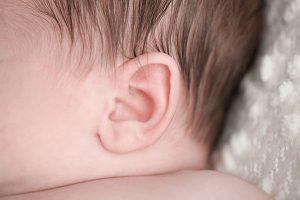Measuring Hearing Loss
Auditory Brainstem Response Screening (AABR)
In AABR screening, clicking sounds are introduced through an earphone or over-the-ear coupler. Electroencephalographic (EEG) response is measured through electrodes placed on the baby’s head and neck. The equipment automatically generates a “pass” or “refer” screening result based on preset criteria.
AABR screening provides information about the auditory pathway up to the brainstem, including the middle ear, the inner ear, and the eighth cranial nerve. Central auditory processing and neuropathy problems, which are more likely when babies have conditions leading to prolonged NICU stays, can be detected. AABR screening is recommended for babies in the NICU, as well as for rescreening well-babies who do not pass otoacoustic emissions screening.
Otoacoustic Emissions Screening (OAE)
In OAE screening, an earphone with a built-in microphone is placed in the ear canal to introduce sounds (clicks or tones) and listen for cochlear outer hair cell response (otoacoustic emissions). If the outer hair cells of the cochlea have been damaged or if incoming sound is blocked before reaching the cochlea, otoacoustic emissions will not be produced. The equipment automatically generates a “pass” or “refer” screening result based on preset criteria.
OAE screening provides information about the auditory pathway up to and including the cochlea. Central auditory processing and neuropathy problems, which affect less than 1% of children with hearing loss, will not be detected by OAE screening. In Hawaii, the well-baby population usually receives OAE screening. Well-babies who do not pass OAE screening are usually rescreened with AABR to obtain information about the auditory pathway up to the brainstem, including the middle ear, the inner ear, and the eighth cranial nerve.
Tympanometry
Tympanometry, including acoustic reflexes, is used to assess middle ear function. Due to the plasticity of a newborn’s ear canal, low frequency (226 Hz) tympanometry is not considered accurate until approximately 6 months of age. High frequency (1000 Hz) tympanometry is therefore preferred for children under 6 months of age, although this procedure may not be available in every location.
Comprehensive Otoacoustic Emissions (OAE) Testing
OAE testing is used to identify outer hair cell dysfunction in the cochlea. Comprehensive, frequency specific OAE testing should be performed to help determine hearing status.
Auditory Brainstem Response (ABR) Testing
ABR testing is used to assess functioning of the cochlea, auditory nerve, and auditory brainstem pathways. Comprehensive ABR tests are the accepted method of evaluating infants who are less than 6 months developmental age. Click and frequency-specific tone burst ABR tests allow an estimation of hearing thresholds for diagnostic purposes and hearing aid fitting. They may also indicate the possibility of conductive hearing loss. Tone burst ABR scores should be corrected for age when determining hearing status. Bone conduction ABR testing should be provided if air conduction results indicate hearing loss.
Behavioral Assessment
Behavioral hearing tests should be provided to validate physiological results. Behavioral test results become more accurate as a baby approaches 6 months of age. Bone conduction behavioral testing should be provided if air conduction results indicate hearing loss.
